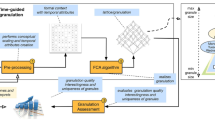Abstract
The spatio-temporal database for a collaborative decision making system supporting land subdivision is “event-driven”. Both various states of spatial objects and the events causing the objects change need to be recorded and manipulated in the database. To achieve this, the authors analyzed the characteristics of events in land subdivision process and studied how events affect the states of spatial objects. An event-based approach was proposed to develop the spatio-temporal data model for the GIS-based computer-supported collaborative work (CSCW) land subdivision system. A formal specification of event and its operators was introduced for describing the execution of events and their sequence. The spatio-overlap and time-meet constraints between parent-child parcels are proposed to represent the linkage between different states of land parcels. With this approach, events and the causal relations between events and states can be recorded and managed in the spatio-temporal database in a land subdivision system. In addition, a new way for simulating system work-flow is also suggested.
Similar content being viewed by others
References
B. Dave. “Computer supported collaborative design,” Proc. of 4th International Conference on Computers in Urban Planning and Urban Management, Melbourne, Australia, 65–76, 1995.
S. Dustdar and R. Huber. “Group decision making on urban planning using desktop multimedia conferencing,” in Multimedia tools and applications, Kluwer Academic, Vol. 6:33–46, 1998.
R. Varna. “Historical data as an explicit component of land information systems,” International Journal of Geographical Information Systems, Vol. 3(1):33–49, 1989.
J. Chen. “Improving urban planning by integrated utilization of remote sensing and GIS,” Proc. of 17th ISPRS Congress, Washington, 1992.
Gail Langran. “Issues of implementing a spatio-temporal system,” International Journal of Geographical Information Systems, Vol. 7(4):305–314, 1993.
Gail Langran. Time in Geographic Information Systems, Taylor & Francis Ltd.: London, UK. 1992.
G. Edwards, D. Gagnon, Y. Bedard, and P. Casault. “Spatial-temporal topology and causal mechanisms in time-integrated GIS: from conceptual model to implementation strategies,” Proc. of the Canadian Conference on GIS'93, 842–857, 1993.
K.K. Al-Taha, R.T. Sondgrass and M.D. Soo. “Bibliography on spatio-temporal databases,” International Journal of Geographical Information Systems, Vol. 8(1):95–103, 1994.
D.J. Peuquet and N. Duan. “An event-based spatiotemporal data model (ESTDM) for temporal analysis of geographical data,” International Journal of Geographical Information Systems, Vol. 9(1):7–24, 1995.
C. Claramunt and Marius Theriault. “Management time in GIS, an event-orient approach,” in J. Clifford, and A. Tuzhilin (Eds.), Recent Advances in Temporal Databases, Springer-Verlag: Heidelberg, Germany 23–42, 1995.
C. Claramunt and Marius Theriault. “Toward semantics for modelling spatio-temporal processes within GIS”, Proc. of International Symposiom on Spatial Data Handling (SDH'96), Netherlands, 2.27–2.43, 1996.
E. Allen, G. Edwards, and Y. Bedard. “Qualitative causal modeling in temporal GIS,” in A.U. Frank and W. Kuhn (Eds.), Spatial Information Theory—A Theoretical basis for GIS. Springer-Verlag: Heidelberg, Germany 397–417, 1995.
T. Cheng and M. Molenaar. “A process-oriented spatio-temporal data model to support physical environmental modeling,” Proc. of 8th International Symposium on Spatial Data Handling, Taylor & Francis, Vancouver, 418–429, 1998.
N.H. Gehani, H.V. Jagadish, and O. Shmueli. “Event speci®cation in an active object-oriented database,” in M. Stonebraker (Eds.), ACM SIGMOD Record. ACM Press: New York, USAVol. 21(2):81–90, 1992.
N.H. Gehani, H.V. Jagadish, and O. Shmueli. “Composite event speci®cation in active databases: Model & implementation,” Proc. of 18th VLDB Conference, Vancouver, British Columbia, Canada, 327–338, 1992.
I. Motakis and C. Zaniolo. “Composite temporal events in active databases: a formal semantics,” in J. Clifford and A. Tuzhilin (Eds.), Recent advances in temporal databases. Springer: 332–351, 1995.
S. Chakravarthy, V. Krishnaprasad, E. Anwar, and S.K. Kim. “Composite events for active databases: semantics, contexts and detection,” Proc. of 20th VLDB Conference, Santiago, Chile, 606–617, 1994.
M.J. Engenhofer and R.D. Franzosa. “Point-set topological spatial relation,” International Journal of Geographical Information Systems, Vol. 5(2):161–174, 1991.
J.F. Allen. “Towards a general theory of action and time,” Artifical Intelligence, Vol. 23(2):123–154, 1984.
B. Knight and J. Ma. “An extended temporal system based on points and intervals,” Information System, Vol. 18(2):111–120, 1993.
J. Chen. “Managing GIS temporal attributes with ono-1NF approach”, Proc. of Integration, Automation and Intelligence in Photogrammetry, Remote Sensing and GISs, Wuhan, China, 338–347, 1994.
J. Chen and J. Jiang. “Spatio-overlap and time-meet relations in land subdivision,” International Archive of Photogrammetry and Remote Sensing, Vol. 32, Part 4, 137–140, 1999.
Author information
Authors and Affiliations
Rights and permissions
About this article
Cite this article
Chen, J., Jiang, J. An Event-Based Approach to Spatio-Temporal Data Modeling in Land Subdivision Systems. GeoInformatica 4, 387–402 (2000). https://doi.org/10.1023/A:1026565929263
Issue Date:
DOI: https://doi.org/10.1023/A:1026565929263




